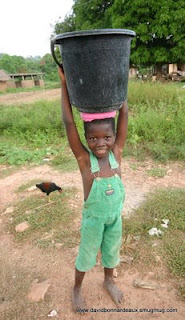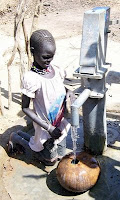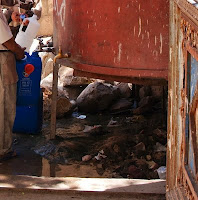Showing posts from category water.
-
Weekly Reading
›How Do Recent Population Trends Matter To Climate Change?, from Population Action International, offers the latest research from this constantly changing area of inquiry.
U.S. Global Health and National Security Policy, a timely report by the Center for Strategic and International Studies, examines major threats to human health and international stability, including HIV/AIDS, SARS, pandemic influenza, and bioterrorism.
In the coming decades, Russia will confront “accelerated population decrease; a dwindling of the working-age population; the general ageing of the population; the drop in number of potential mothers; a large immigrant influx; and a possible rise in emigration rates,” warns a new report from the UN Development Programme.
In The National Interest and the Law of the Sea, the Council on Foreign Relations’ Scott Borgerson argues that ratifying the Law of the Sea Convention is vital to protecting the United States’ national security, economic, and environmental interests.
David Sullivan of Enough debates Harrison Mitchell and Nicolas Garrett of Resource Consulting Services (RCS) on the links between conflict and mining in the Democratic Republic of the Congo (DRC). RCS recently published a report arguing that mineral extraction is key to DRC’s development and not the primary cause of conflict in North Kivu.
Responding to the ubiquitous Monsanto ads that ask, “9 billion people to feed. A changing climate. Now what?,” Tod Preston of Population Action International responds, “family planning and empowering women, that’s what!”
Water and War, a publication of the International Committee of the Red Cross (ICRC), outlines how the ICRC provides access to clean water during conflict and humanitarian disasters. -
Weekly Reading
›The authors of Asia’s Next Challenge: Securing the Region’s Water Future, a report by the Asia Society, argue that population growth, urbanization, and climate change are converging to make water an important security issue in Asia. The authors argue for including water in policy and development discussions, but warn against “securitizing” the issue.
China’s population is rapidly aging while the country is still developing and modernizing, explains China’s Long March to Retirement Reform: The Graying of the Middle Kingdom Revisited, a report by the Global Aging Initiative of the Center for Strategic and International Studies (CSIS). The report recommends steps to ensure that China’s aging citizens are not left without a safety net. Another report by CSIS’s Global Aging Initiative, Latin America’s Aging Challenge: Demographics and Retirement Policy in Brazil, Chile, and Mexico, argues that these countries have a rapidly narrowing window of opportunity to prepare to meet the needs of their aging populations.
According to a study published in the British Journal of Zoology, wild populations of major grazing animals—including giraffes, impala, and wildebeest—in Kenya’s Maasai Mara National Reserve decreased significantly from 1989-2003. “Researchers found the growing human population has diminished the wild animal population by usurping wildlife grazing territory for crop and livestock production to support their families,” reports the International Livestock Research Institute.
On April 22, Bill Butz of the Population Reference Bureau, Paul Ehrlich of Stanford University, and Hania Zlotnik of the UN Population Division discussed world population trends on the Diane Rehm Show. -
Weekly Reading
›“The Arctic could slide into a new era featuring jurisdictional conflicts, increasingly severe clashes over the extraction of natural resources, and the emergence of a new ‘great game’ among the global powers,” argue Paul Berkman and Oran Young, two researchers at the University of California, Santa Barbara, in Science. “However, the environment provides a physical and a conceptual framework to link government interests in the Arctic Ocean, as well as a template for addressing transboundary security risks cooperatively.” In the Washington Times, Paula Dobriansky, former U.S. undersecretary of state for democracy and global affairs, argues that the Antarctic Treaty offers lessons for dealing with competing territorial claims in the Arctic.
An article by Fred Pearce in Yale Environment 360, “Consumption Dwarfs Population As Main Environmental Threat,” has re-energized the debate over population’s contribution to climate change. For more, see Suzanne Petroni’s article “An Ethical Approach to Population and Climate Change” in ECSP Report 13.
Time interviews Laurel Neme, author of Animal Investigators: How the World’s First Wildlife Forensics Lab Is Solving Crimes and Saving Endangered Species, about the illegal wildlife trade. Neme will speak at the Wilson Center on May 20.
Slate’s William Saletan discusses the skewed sex ratio in China. For more on this topic, see Richard Cincotta’s review of Bare Branches: The Security Implications of Asia’s Surplus Male Population.
According to Rose George, author of The Big Necessity: The Unmentionable World of Human Waste and Why It Matters, “If you invest a dollar in sanitation, you save seven dollars in health-care costs.” Audio is available of a recent talk featuring George and ECSP Director Geoff Dabelko.
Time reports on Mexico’s water crisis. (See “Water Stories” for more on water and sanitation in Mexico.) It also features photo slideshows on the politics of water in Central Asia and the global water crisis.
In a paper published in Ecology (subscription required), Kevin Lafferty, a research ecologist for the United States Geological Survey at the University of California Santa Barbara, argues that climate change may not necessarily expand the range of disease vectors, as many scientists have argued. -
Water’s Role in International Development
› A mark of a good event is that it generates further debate, questions, and ideas. “Water and International Development: A Dialogue,” a recent discussion at The Johns Hopkins University School for Advanced International Studies, was such an event. Geoff Dabelko, director of the Environment Change and Security Program at the Wilson Center, and Aaron Salzberg, special coordinator for water resources at the U.S. Department of State, went head-to-head to discuss water’s role in international development.
A mark of a good event is that it generates further debate, questions, and ideas. “Water and International Development: A Dialogue,” a recent discussion at The Johns Hopkins University School for Advanced International Studies, was such an event. Geoff Dabelko, director of the Environment Change and Security Program at the Wilson Center, and Aaron Salzberg, special coordinator for water resources at the U.S. Department of State, went head-to-head to discuss water’s role in international development.
The discussion between Dabelko and Salzberg touched upon many issues I ran into while trying to program Water for the Poor Act funding while working as a natural resources adviser for the Economic Growth Office at the U.S. Agency for International Development (USAID) mission in Ghana. Once we received the funding, there was an intra-office debate among:- People who wanted to make drip-irrigation work we were already funding fit the Water for the Poor Act definition;
- People who thought the funds should be spent on a narrow set of water and sanitation interventions, such as borehole/latrine construction and water purification tablets; and
- People who thought the funds should be spent on the larger-scale water and sanitation infrastructure that Ghana so desperately needs.
USAID mission offices have specific strategic priorities and associated operational plans, which dictate the makeup of the staff employed at any given time. In this case, there was no one water specialist who could take on this important task. I had an M.S. in water management, so I was passed the baton. If the Water for the Poor Act is going to have a significant impact, USAID missions must have the technical capacity to assimilate the funds.
Dabelko and Salzburg’s discussion brought up even more questions for me: How can the United States reconcile its bilateral earmark funding for water with the growing trend toward donor coordination—for instance, under the 2005 Paris Declaration, or, in the case of Ghana, the Multi-Donor Budget Support fund, which encourages donors to contribute direct financial support to the Ghanaian government to implement its Growth and Poverty Reduction Strategy? Is there a need to have water specialists assigned to USAID missions, rather than relying on specialists in Washington, D.C.? How can we make municipal financing mechanisms for infrastructure more attractive to Western funders and host-country governments? Although Dabelko and Salzburg might not have had all the answers to these questions, I’m heartened that they and other water experts are tackling the tough issues.
David Bonnardeaux is a freelance consultant on rural development and natural resource management for the World Bank, USAID, and CARE, among others. He is also an amateur photographer (www.davidbonnardeaux.smugmug.com). His next port of call is Vietnam.
Photos: Top: Boy pumping water, Volta Region, Ghana. Bottom: Girl collecting water from lake, Volta Region, Ghana. Courtesy of David Bonnardeaux. -
Reading Radar– A Weekly Roundup
›April 10, 2009 // By Wilson Center StaffUncharted Waters: The U.S. Navy and Navigating Climate Change, a working paper by the Center for a New American Security, examines climate change’s implications for the U.S. Navy.
Defense Secretary Robert Gates recently chose Admiral James Stavridis, the former head of U.S. Southern Command known for his “smart power”/“sustainable security” approach, to lead U.S. European Command.
An Economist article highlights some of the linkages between water and political instability, energy, food, demography, and climate change.
The Governance of Nature and the Nature of Governance: Policy That Works for Biodiversity and Livelihoods, a report by the International Institute for Environment and Development, explores the success of local-level conservation. It features case studies from India, Tanzania, and Peru.
Sheila Herrling of the Center for Global Development argues that the USAID Administrator should become a permanent member of the National Security Council.
The Nation wonders whether nations go to war over water; Nature (subscription required) and Slate say “no.” ECSP has weighed in on this issue in the past.
Lisa Friedman of ClimateWire reports on Bangladesh’s attempts to prepare for the impacts of climate change. -
At the Fifth World Water Forum, Africa Steps Up
› A record-breaking 28,000 people, including five heads of state, participated in the Fifth World Water Forum in Istanbul, Turkey, last month. I was there, too, excited to be discussing this year’s theme, “Bridging Divides for Water.” Much of the conversation centered on how to bridge the remaining divides in meeting the Millennium Development Goals (MDGs)—especially MDG 7, which aims to halve the proportion of people without sustainable access to safe drinking water and basic sanitation by 2015.
A record-breaking 28,000 people, including five heads of state, participated in the Fifth World Water Forum in Istanbul, Turkey, last month. I was there, too, excited to be discussing this year’s theme, “Bridging Divides for Water.” Much of the conversation centered on how to bridge the remaining divides in meeting the Millennium Development Goals (MDGs)—especially MDG 7, which aims to halve the proportion of people without sustainable access to safe drinking water and basic sanitation by 2015.
While notable progress has been made in many regions of the world, such as China and India, other areas, particularly sub-Saharan Africa, lag woefully behind. According to the most recent numbers (2006) by UNICEF and the World Health Organization, only 31 percent of the population in sub-Saharan Africa has access to sanitation, and there are 38 sub-Saharan African countries where sanitation coverage is less than 50 percent. Access to improved drinking water sources has increased to 64 percent across the region; however, increases in coverage are not keeping pace with population growth, and the current rate of provision is not adequate to meet the MDG drinking-water target.
The Fifth World Water Forum, however, marked a hopeful new development. For the first time, the region of the world with the most serious water challenges, Africa, used the Forum to announce an internally driven water and sanitation agenda with a united voice. With support from the African Development Bank, the African Union and the African Ministerial Conference on Water (AMCOW) unveiled a plan to implement existing political commitments to water and sanitation. An “Africa Regional Paper” informed by the First African Water Week, held in Tunis in March 2008, presents African perspectives on each of the themes of the Forum (global change and risk management; advancing human development and the MDGs; managing and protecting water resources; governance and management; finance; education, knowledge, and capacity development), with a key message of delivering on existing commitments. In response to this agenda, the G8 countries announced increased aid to Africa’s water sector.
The desire to solve the world’s water crisis has generated many reports and frameworks over the years, including the Brundtland Commission’s report “Our Common Future” and the World Water Forum process itself. But perhaps nothing is as effective as a proactive, united stance from sub-Saharan Africans themselves, which could go a long way toward ensuring aid is used appropriately and efficiently. The fact that South Africa will host the Sixth World Water Forum in March 2012 should provide another impetus for meeting water and sanitation targets on the continent.
Hope Herron is an environmental scientist with Tetra Tech, Inc. She is currently researching water security issues in the context of the new U.S. Africa Command and U.S. defense, diplomacy, and development frameworks.
Photo: A Sudanese girl fills a water jug at a pump. Courtesy of Flickr user Water for Sudan. -
In Yemen, Water’s Role in the War on Terror
›March 27, 2009 // By Will Rogers “Sana’a might very well become the first capital in the world to run out of water,” write Gregory D. Johnsen and Christopher Boucek in a February 2009 article in Foreign Policy. With massive population growth, rapidly shrinking freshwater availability, and weak governance, Yemen’s unsustainable water management policies are exacerbating the threat of international terrorism as the state devolves into a sanctuary for al Qaeda jihadists and other transnational criminals.
“Sana’a might very well become the first capital in the world to run out of water,” write Gregory D. Johnsen and Christopher Boucek in a February 2009 article in Foreign Policy. With massive population growth, rapidly shrinking freshwater availability, and weak governance, Yemen’s unsustainable water management policies are exacerbating the threat of international terrorism as the state devolves into a sanctuary for al Qaeda jihadists and other transnational criminals.
Today, Yemen is among the world’s most water-scarce countries. According to the most recent data collected in 2005, Yemen’s freshwater availability has dropped to a mere 186 cubic meters per capita per year – well below the international water poverty line of 1,000 cubic meters per capita per year. Below that, water begins to severely limit “economic development and human health and well-being.”
And since the latest data collection, according to Johnsen and Boucek, overexploitation of groundwater aquifers to satisfy a burgeoning population has resulted in “dramatically falling water tables—up to several meters per year in some places.”
To make matters worse, an annual population growth rate of 3.2 percent, driven by a total fertility rate of 6.2 children per woman, means the population will grow from 22.2 million today to 35.2 million by 2050, putting further pressure on an already-scarce resource.
In Yemen, the “lack of any serious legal oversight, reckless irrigation techniques, and unregulated private exploitation” are clear indicators of poor governance. Nevertheless, the government has begun working with the World Bank to implement an integrated water management program. “Support for the water sector is receiving high priority,” said Nabil Shaiban of Yemen’s Ministry of Planning and International Cooperation, in an interview with IRIN News.
But despite these efforts, the government’s weakness and the country’s “gun-slinging tribal culture” present serious challenges to water management. According to IRIN News, “tribesmen seize control of water projects nearing completion, intending to use them for irrigating their farms.” This occurs with about “80 percent of projects in rural areas,” Ahmed al-Sufi, an information officer with Yemen’s National Water and Sanitation Foundation, told IRIN News.
And so the problems of poor water management and weak governance are circular. As water scarcity worsens, the government’s attempts to mitigate it are undermined by its weak control over the state. But without successful policies to mitigate water scarcity, the government’s legitimacy is further weakened.
With water woes aggravating Yemeni citizens and weakening the government’s authority, al Qaeda and other transnational terror groups are recruiting jihadists and using ungoverned areas as training grounds and safe havens. Forty-five percent of Yemen’s population is under 15 years old—and some claim al Qaeda is now actively recruiting boys as young as 12. With water scarcity worsening economic and human development, Yemen’s youth are particularly susceptible to al Qaeda’s promises of social justice and opportunities for advancement.
Al Qaeda recently made its capabilities in Yemen clear with a September 18, 2008, attack against the U.S. embassy in Sana’a. Several car bombs and rocket-propelled grenades killed 16 people—the deadliest attack against a U.S. target in Yemen since the bombing of the U.S.S. Cole in 2000. According to The Economist, last March “al Qaeda websites posted a message advising members to head for Yemen.”
To be clear, water scarcity is not the only issue plaguing the Gulf state. Falling oil prices and mismanaged oil reserves are making Yemen’s chronic economic and human development problems much worse. But assistance from the international community in implementing effective water-management policies would lend credibility to the government and could bolster its ability to prevent al Qaeda from training terrorists within its borders.
According to the U.S. Army field manual on stability operations, “The greatest threats to our national security will not come from emerging ambitious states but from nations unable or unwilling to meet the basic needs and aspirations of their people.” If Yemen’s government cannot provide even a minimal level of water security for its citizens, it risks becoming a failed state on par with Somalia or Zimbabwe.
Over the long term, a comprehensive approach to development that balances voluntary family planning with effective natural resource management would help reduce pressure on scarce resources and bring lasting stability to the country, while serving U.S. national security interests in the War on Terror.Photo: In Taiz, south of the capital city of Sana’a, children fill up their water jugs outside a mosque. Courtesy of flickr user Osama Al-Eryani.
-
Water a National Security Issue, Says Senator Richard Durbin
›March 20, 2009 // By Will Rogers “Water access is no longer simply a global health and development issue; it is a mortal and long-term threat that is increasingly becoming a national security issue,” said Senator Richard Durbin at a March 17, 2009, event on Capitol Hill. Introducing the Paul Simon Water for the World Act of 2009, Senator Durbin called for renewed American leadership on the global water crisis plaguing billions around the world.
“Water access is no longer simply a global health and development issue; it is a mortal and long-term threat that is increasingly becoming a national security issue,” said Senator Richard Durbin at a March 17, 2009, event on Capitol Hill. Introducing the Paul Simon Water for the World Act of 2009, Senator Durbin called for renewed American leadership on the global water crisis plaguing billions around the world.
“The United States needs to do much more to ensure that global water access is protected and expanded,” he said. Senator Durbin’s remarks come on the heels of the Fifth Global Water Forum held in Istanbul, Turkey this week, and precede UN World Water Day on March 22, 2009.
“The global water crisis is a quiet killer,” Durbin said. “In the developing world, 5,000 children die every day from easily preventable water-related illnesses such as cholera, typhoid, and malaria, diseases that have been all but eradicated in wealthier nations.”
The Water for the World Act of 2009 expands a commitment from the earlier Paul Simon Water for the Poor Act of 2005, which has had notable success in focusing U.S. aid on water-related assistance. From 2007-2008, for instance, the U.S. helped provide 2 million people with access to an improved source of drinking water and more than 1.5 million people to improved sanitation.
But these efforts need to be scaled up to reach the billions of people without clean water. According to Representative Earl Blumenauer, speaking at the same event, there are more people in the world today without access to adequate sanitation than the populations of China and India combined. The Water for the World Act of 2009 will seek to provide “100 million people around the world with sustainable access to clean water and sanitation by 2015,” said Durbin.
In addition, if passed, the act will make water a development priority for U.S. foreign assistance and “designates within the State Department a high-level representative to ensure that water receives priority attention in our foreign policy, and establishes a new Office of Water at USAID to implement development assistance efforts related to water,” Durbin said.
Access to clean water and adequate sanitation is a cornerstone for sustainable development around the world. Developing countries will not be able to build their economies or bring their resources to fruition if people in these countries have to travel for hours to find water, or are “too sick from drinking unsafe water, to work or to go to school,” Durbin warned.
Improving access to safe water will not only reduce mortality from waterborne illness, but will help provide long-term stability in countries that suffer from population pressures due large population growth from high total fertility rates. In developing countries, 3,900 children under 5 years old die every day from waterborne illness. “Mothers who fear the deaths of their children bear more, in a desperate race against the odds,” said Senator Durbin. While access to education and family planning programs is also essential to reducing high fertility rates in developing countries, so too is basic access to safe drinking water and sanitation.
But funding for water infrastructure and sanitation programs is just the first step. In developing countries, poor governance is a major roadblock to implementing successful development projects. Unregulated privatization of water can prevent the “voiceless and powerless” poor from gaining access to the water services they need, Durbin cautioned.
To address the challenges of governance, the bill will help “build the capacity of poor nations to meet their own water and sanitation challenges,” Durbin said, by providing “technical assistance, best practices, credit authorities, and training to help countries expand access to clean water and sanitation.”
Working to ensure access to safe water and adequate sanitation can help implement the “smart power” strategy the U.S. desperately needs during a period when the world is redefining America – a strategy to help provide “things people and governments in all quarters of the world want but cannot attain in the absence of American leadership,” writes the Center for Strategic and International Studies (CSIS) Commission on Smart Power.
CSIS President John Hamre said the U.S. should re-establish its moral leadership in the world by making a serious commitment to increasing access to clean water and adequate sanitation. CSIS recently issued a Declaration on U.S. Policy and the Global Challenge of Water, endorsed by more than 35 leaders in business, government, and academia, and called on President Obama “to launch a bold new U.S. campaign to address the global challenge of water.”
“Throughout history, civilized nations have put aside political differences to address compelling issues of life and survival,” said Senator Durbin. “Our generation owes the world nothing less.”
Photo: Senator Richard Durbin. Courtesy of the Office of Senator Richard Durbin.




 A record-breaking 28,000 people, including five heads of state, participated in the
A record-breaking 28,000 people, including five heads of state, participated in the  “Sana’a might very well become the
“Sana’a might very well become the  “Water access is no longer simply a global health and development issue; it is a mortal and long-term threat that is increasingly becoming a
“Water access is no longer simply a global health and development issue; it is a mortal and long-term threat that is increasingly becoming a 

